Creating the Perfect Cage for Green Cheeked Conures


Intro
Creating a comfortable and pleasant habitat for a green-cheeked conure is crucial to the well-being of these lively birds. Understanding the specific requirements for their cage environment does more than just provide shelter; it fosters happiness and enables them to thrive in a home setting. Birds are sensitive creatures, and an ideal environment plays a significant role in their health, both physical and emotional.
In this guide, we will delve into the multiple facets of establishing the perfect cage for your feathered companion. From daily care routines and cage setup to behavioral insights and enriching activities, each section is designed to offer you a comprehensive understanding of what it takes to create an inviting environment.
Before diving into the nitty-gritty details, consider that green-cheeked conures are social birds, thriving on interaction and stimulation. Thus, it’s essential to not only focus on their cage but also think about how their environment fits into their broader lifestyle.
Let’s explore the vital components of the ideal conure cage, ensuring that your little friend can flap their wings in comfort and joy.
Understanding Green Cheeked Conures
When it comes to keeping green-cheeked conures as pets, having a solid understanding of their nature is the first step toward caring for them properly. These little companions bring joy and liveliness to any home, but their needs are distinct. Recognizing their characteristics, behaviors, and social requirements can enhance the relationship between the bird and its owner.
Physical Characteristics
Green-cheeked conures are small parrots, typically measuring about 9 to 10 inches in length. Their feathers are a delightful mix of green, yellow, and hints of blue that stand out brilliantly in different lighting. Notably, they have a distinctive cinnamon-colored breast and a dark crown. Their compact size and vibrant coloration make them a popular choice among bird enthusiasts. Also, their beaks are quite strong, designed to crack seeds and nuts easily, a testament to their natural diet, which primarily consists of seeds, fruits, and vegetables.
Having a keen eye for these physical traits not only helps owners recognize their furry friends but will also aid in spotting any potential health issues that might arise. Any sudden changes, such as dull feathers or unkempt appearances, could be indicators that something is amiss. Hence, an awareness of these physical characteristics lays the groundwork for good health monitoring practices.
Behavioral Traits
Behaviorally, green-cheeked conures are known for their playful and curious nature. They are social birds with a penchant for mischief; they can often be seen hanging upside down or exploring every nook and cranny of their environment. Their intelligent minds allow them to learn tricks and mimic sounds, which can be quite entertaining. However, this playful spirit also means that they require plenty of interaction to stay happy and engaged.
These birds thrive on routine and can become quite attached to their owners. Some may even exhibit signs of jealousy if they feel neglected. Recognizing these behavioral nuances is essential; understanding them can lead to a more balanced companionship. Positive reinforcement methods work wonders when training these spirited creatures, setting the stage for a harmonious living situation.
Social Needs
Socially, green-cheeked conures are flock-oriented creatures. In the natural world, they live in groups, which influences their need for social interaction. Owners must recognize that keeping a solitary bird can sometimes lead to loneliness and behavioral problems. Having a partner can help fulfill their social instincts, although it's crucial to ensure that the birds get along.
When integrating their social environment, it's vital to provide them with sufficient time outside the cage, allowing them to bond with their humans or other birds. Activities such as shared playtime can promote well-being, and it wouldn't hurt to introduce safe toys or simple puzzles to stimulate their minds further. A well-rounded social experience contributes tremendously to their quality of life, leading to a content and healthy bird.
"Understanding your green-cheeked conure is not just about looking at them; it's about engaging with their world and learning to foster a space that caters to who they are."
Choosing the Right Cage
Selecting the right cage is a pivotal step in ensuring your green-cheeked conure thrives. These birds flourish in environments that not only cater to their physical needs but also promote their innate behaviors. A well-chosen cage will enhance their well-being and allow them to express themselves, which is crucial given their active nature. By understanding the elements contributing to a conducive habitat, you can create a nurturing space that encourages exploration, play, and social interaction.
Cage Size Requirements
Cage size can’t be underestimated when it comes to housing green-cheeked conures. Ideally, their cage should be spacious enough for them to move around freely. A minimum dimension often recommended is around 30 inches wide by 24 inches deep and 36 inches high. However, bigger is better. The more room they have, the better they can stretch their wings, climb, and play.
On top of that, a larger cage allows you to incorporate various accessories such as perches and toys, enabling stimulation during their downtime. Remember, freedom of movement is vital to their well-being. It’s not just about fitting them into a space; it’s about creating an environment where they can thrive. When looking at cages, always visualize how you’ll set it up and consider their need for flight and exploration.
Cage Material Considerations
When it comes to materials, safety should be your guiding principle. The cage should be made from non-toxic materials. Stainless steel is an excellent choice, as it is not only durable but also free from harmful coatings that can flake off. Avoid cages painted with toxic paint. You want your conure to remain safe from any risks associated with their environment.
Once the cage is set up, sharp corners or hazardous bits can pose further dangers. A good cage will have rounded edges to minimize injuries. Also, ensure the bars are appropriately spaced. For green-cheeked conures, a spacing of half an inch is ideal; anything wider might allow them to escape or, worse, get stuck.
Feeding and Watering Stations
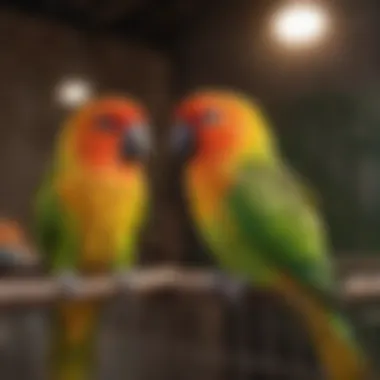
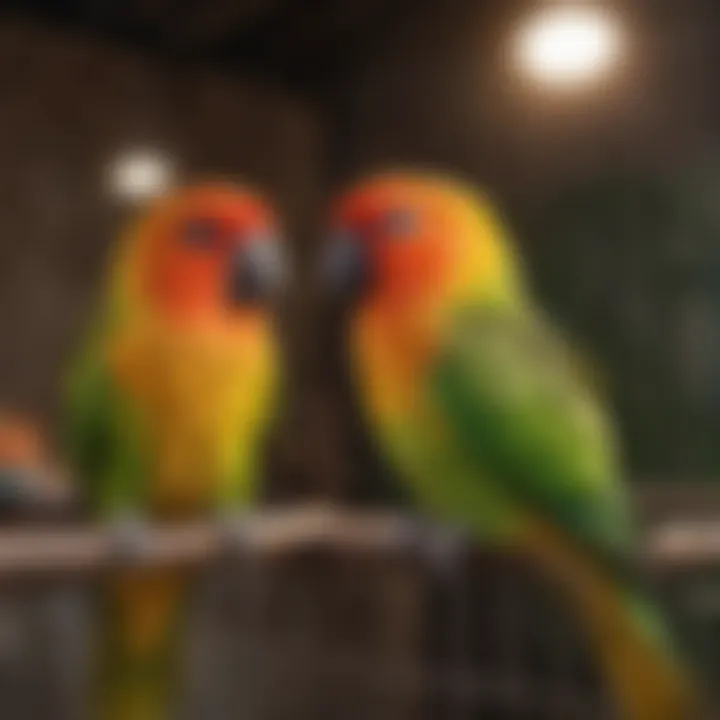
Feeding and watering stations are cornerstone elements of the cage setup. These should be easily accessible, allowing your conure to eat and drink without struggle. Opt for stainless steel or ceramic bowls, as they are easier to clean and reduce the risk of bacterial growth.
Placement is crucial too. The food and water bowls should be positioned at different areas in the cage, keeping them away from the perches. Not only does this encourage movement, but it also fosters natural foraging behaviors, which are vital for their mental health. You might want to consider using foraging toys to further simulate this behavior, but start simply until your conure gets the hang of it.
"An enriched environment fosters better mental health in birds; every morsel they've to work for becomes a little adventure."
In summary, the right cage sets the stage for your green-cheeked conure to live its best life. Size, material, and feeding stations are not just mundane considerations; they are the foundation of a happy, healthy bird.
Cage Placement and Environment
When it comes to caring for green-cheeked conures, the placement of their cage plays a pivotal role in their overall well-being. The right environment can significantly influence their behavior, health, and happiness. By understanding the importance of cage placement, pet owners can create a nurturing habitat that suits the unique needs of these lively birds.
Ideal Location
Finding the perfect spot for your conure's cage isn’t just about aesthetics—it’s about creating a safe, stimulating, and engaging atmosphere.
- Visibility is Key: Green-cheeked conures are social creatures, thriving on interaction. Positioning their cage in a high-traffic area can keep them engaged with family life. This way, they can observe daily activities, which satisfies their curiosity and reduces feelings of isolation.
- Avoiding Direct Sunlight: While these birds love light, too much direct sunlight can be harmful. Ideal locations are well-lit but not scorching. A spot near a window that gets filtered light might just do the trick. This allows them to feel the warmth without risking overheating.
- Height Matters: Birds are naturally inclined to perch high in the trees. Hence, placing the cage at eye-level or a bit higher can make your conure feel more secure. It mimics their natural habitat, allowing them to feel like they’re in control of their surroundings.
Safety from Hazards
Safety should be at the forefront of any bird owner's mind. An ideal cage setup must effectively mitigate hazards that could harm your green-cheeked conure.
- Away from Toxic Plants: Certain common houseplants can be toxic to birds. Before placing the cage, identify and remove any plants or flowers that can be harmful. Make sure the area is free from any hazardous materials, such as cleaning supplies or electrical cords, that can be easily accessed by curious beaks.
- Avoid Drafty Areas: Birds are sensitive to cold drafts. Place the cage in areas that are shielded from open windows and doors, where gusts might sneak in. Drafts can lead to respiratory issues, and it’s in your best interest to prevent any unnecessary stress on your feathered friend.
- Secure Placement: Ensure that the cage is stable. An unstable surface can lead to accidents either due to the cage tipping over or the bird launching itself too eagerly and falling. Make sure the ground is firm and the cage is safely positioned to avoid any unfortunate tumbles.
Temperature and Light Considerations
Temperature and lighting are two critical factors in maintaining an optimal living environment for green-cheeked conures.
- Maintaining a Comfortable Temperature: Conures thrive in a temperature range between 65°F to 80°F (18°C - 27°C). It's essential to monitor the environment closely, especially during seasonal changes. Avoid extremes, and if necessary, consider using heaters or fans strategically placed to regulate the temperature without causing drafts.
- Balanced Lighting: Natural light is energizing for conures, promoting healthy behaviors. However, be sure to establish a routine for their exposure to light. Overexposure can lead to agitation or stress. Aim for 10-12 hours of daylight and a similar duration of darkness to help maintain their circadian rhythms. This mimics the natural day-night cycle they would experience in the wild.
"A well-placed cage not only provides a sanctuary for your bird but also enhances the bond between you and your pet."
By giving thoughtful consideration to cage placement and the surrounding environment, you allow your green-cheeked conure to live a harmonious life reminiscent of their natural setting. A little effort in creating the right environment can go a long way in ensuring their happiness and health.
Cage Accessories for Enrichment
Creating an enriching environment for green-cheeked conures is paramount to their happiness and well-being. Accessories in their cages serve not just as decor but as vital tools for mental and physical stimulation. These additions provide opportunities for exploration, play, and comfort, ensuring that your conure thrives within their space. Each accessory carries its own set of benefits, so understanding their features can help in crafting a lively and engaging habitat.
Perches and Their Types
Perches are an essential fundamental for any bird cage. They provide a resting place while also supporting foot health. The type of perch can vary significantly, and each type contributes differently to the conure’s environment.
- Natural Wood Perches: These mimic the birds' natural habitat and tend to be more gentle on their feet. Different diameters encourage exercise, as the birds grip and balance.
- Bamboo Perches: Lightweight and durable, bamboo provides a unique texture for birds to grip, which can help to keep their claws healthy and worn down.
- Sandpaper Perches: Though functionally useful for toe nail maintenance, they should be used sparingly to avoid over-wear of sensitive foot pads.
- Swing Perches: These add movement to the cage. Green-cheeked conures love to swiggle, and the added motion can keep them entertained.
In deciding on the perches, aim for varied heights and materials, ensuring your bird never gets bored and always has options.
Toys for Mental Stimulation
Keeping a green-cheeked conure’s mind busy is just as crucial as their physical activity. Toys are a fantastic way to encourage brain engagement, prevent boredom, and reduce the likelihood of destructive behavior. Here’s how to optimize their playtime:
- Shreddable Toys: These allow your bird to engage in natural foraging behaviors. Think of paper or palm leaves that your conure can rip apart. These toys satisfy their strong beak and instinct to gnaw.
- Interactive Puzzles: Toys that involve problem-solving, like foraging puzzles that hide treats, stimulate intelligence. They compel the bird to think, which is crucial for their mental agility.
- Climbing Toys: These provide not only exercise but also skills to navigate their habitat. Ropes and nets entice your bird to climb, engage, and explore.

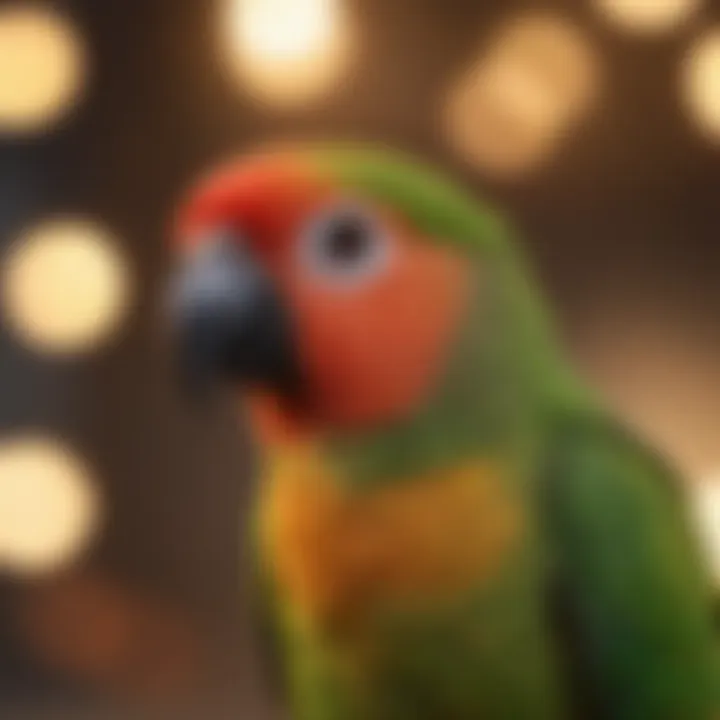
Regularly rotating toys is a smart practice. It keeps things fresh and exciting, drawing interest back to the cage repeatedly.
Nesting and Hiding Spots
Creating spaces where your green-cheeked conure can hide or nest is equally important. These areas provide a sense of safety—a place where they can retreat when feeling overwhelmed.
- Hiding Cubes: Soft, cozy cubes offer an ideal hiding place. When placed in a corner of the cage, it allows your birds to feel secured while still being part of the environment.
- Nesting Materials: Although they may not breed often, providing materials like shredded paper or soft fabric allows them to indulge in their natural nesting instincts.
- Tunnels and Tents: Simple fabric tunnels can be a fun way to encourage exploration while offering a snug place to curl up. Birds love the adventure of moving through them.
Just like any other cage accessory, ensuring that these items are safe and free of harmful components is crucial. Regular checks for wear and tear can prevent accidents and keep your feathery friends entertained.
Enriching your green-cheeked conure's environment is not just about physical accessories. It's about creating a lively, interactive space that feels safe and nurturing for your bird. A thoughtful layout invites exploration and play, making every corner a potential adventure.
Maintaining Cleanliness and Hygiene
Keeping your green-cheeked conure's cage clean is not just about aesthetics; it's a crucial part of ensuring your bird's overall health and happiness. A dirty cage creates a breeding ground for bacteria and parasites, which can lead to illnesses or infections. Regular cleanliness is also important for your own health, as droppings may carry pathogens that can affect humans.
Benefits of Maintaining Hygiene
- Health Protection: Regular cleaning minimizes the risk of diseases that your bird might contract through contaminated food or water sources.
- Behavioral Well-being: A clean environment promotes better behavior. Birds often peck at droppings and uneaten food, which can lead to health issues if the cage isn’t cleaned frequently.
- Reduced Odors: Keeping the cage clean helps combat unpleasant smells that can develop from waste accumulation.
While maintaining cleanliness can seem like a chore, it’s rather manageable with a good routine and some simple strategies.
Daily Cleaning Routines
Daily cleaning routines should ideally take no longer than fifteen minutes of your day. Here are essential tasks to incorporate into your routine:
- Remove Droppings: Use a handheld vacuum or a damp cloth to wipe away droppings from perches, the bottom of the cage, and around feeding areas.
- Change Food and Water: Replace old food with fresh options and refill water bowls daily. This not only assures freshness but also encourages your conure to eat healthily.
- Check Toys and Accessories: Regularly inspect toys and perches for any signs of wear, dirt, or food build-up, and clean or replace them as necessary.
- Spot Cleaning: Quickly wipe down any surfaces that need attention rather than letting mess build up.
Engaging in these tasks daily can keep things manageable, ensuring that the overall environment is inviting for your green-cheeked conure.
Deep Cleaning Tips
Deep cleaning should happen at least once a month to maintain a thoroughly hygienic space for your bird. These tasks require a bit more time but yield a great deal of benefit:
- Disassemble the Cage: Remove all toys, dishes, and perches. Take apart any removable parts of the cage for thorough cleaning.
- Use Safe Cleaning Solutions: Opt for a mild soap solution or a bird-safe disinfectant to scrub down each part. Beware of harsh chemicals that may be toxic to birds.
- Rinse Well: After cleaning, be sure to rinse everything properly and let it dry completely before reassembling the cage.
- Clean Outside the Cage: Dust and wipe down the area surrounding the cage as well, removing any stray seeds or droppings that might have escaped.
- Vacuum Regularly: Don't forget to vacuum any debris that has fallen onto the floor around the cage, as it can attract unwanted pests.
Remember: Keeping a rigorous cleaning schedule not only benefits your bird but also creates a more pleasant atmosphere in your home. The effort invested pays off in a healthier and more vibrant bird.
Implementing these cleaning routines and deep cleaning tips can form the backbone of a solid maintenance plan, allowing your green-cheeked conure to thrive in a sanitary environment.
Monitoring Health and Well-Being
Keeping a watchful eye on your green-cheeked conure’s health is as vital as ensuring they have a spacious cage and are well-fed. Monitoring their well-being involves a blend of recognizing any shifts in their behavior and understanding the importance of routine veterinary check-ups. Let’s dive into why this is essential for the long-term happiness of your feathered friend.
Signs of Stress or Illness
It’s crucial to be familiar with the signs that your bird may be feeling under the weather or stressed. Unlike us, birds don’t verbalize their discomfort. Their subtle hints require bird owners to be observant. You should look for:
- Changes in Appetite: If your conure suddenly loses interest in their favorite foods or consumes significantly less, it could indicate a problem.
- Altered Behavior: A conure that typically chirps cheerfully but suddenly becomes quiet may be experiencing stress or illness. Look for a withdrawn demeanor.
- Physical Changes: Feather plucking or a ruffled appearance is a red flag. It might be a sign of discomfort or even illness.
- Droppings: This often overlooked aspect can tell you volumes about your bird’s health. Watery droppings may signal gastrointestinal issues, while differently colored droppings can indicate dietary or health concerns.
- Changes in Vocalization: If your conure stops vocalizing or starts emitting unnatural sounds, it’s best to take note, as this can signal distress.
Recognizing these changes early can make a world of difference. The faster you address potential issues, the better chance your green-cheeked conure has at a swift recovery.
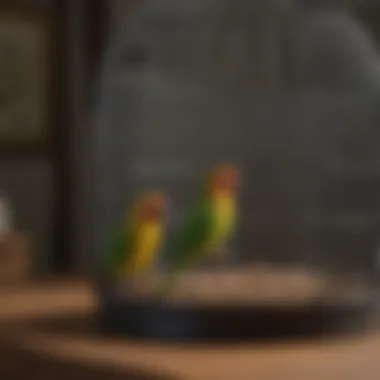
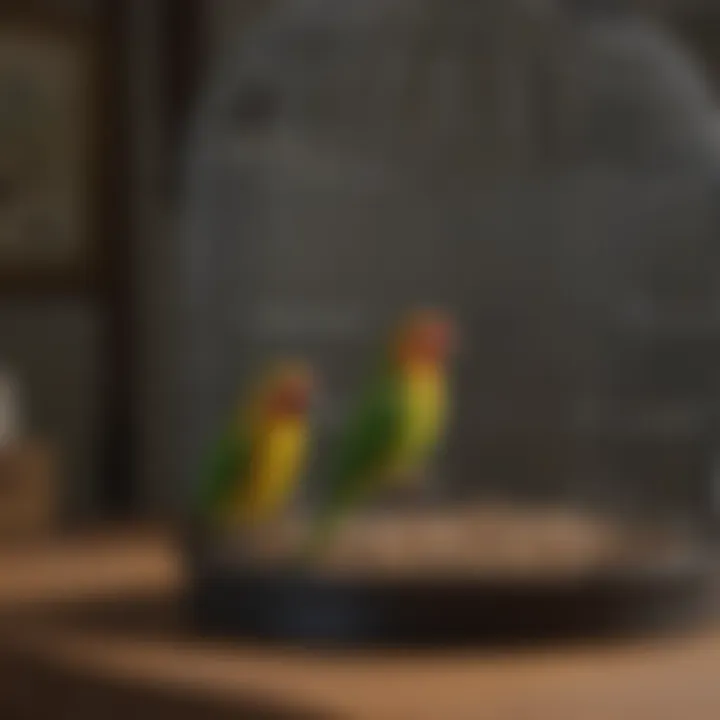
Routine Veterinary Check-Ups
Getting a vet’s opinion is more than just a precaution; it’s an investment in your bird’s life. Regular veterinary check-ups should ideally be scheduled every 6 to 12 months for most green-cheeked conures. During these visits, a vet will examine your bird for common health issues, administer vaccinations if necessary, and offer nutritional advice.
Benefits of these visits include:
- Early Detection: Many health issues don’t show symptoms until they’re advanced. A vet can catch these before they escalate.
- Weight Management: The vet helps track your bird’s weight, which can fluctuate dramatically due to diet or health issues.
- Behavioral Guidance: Veterinary professionals can provide tips on keeping your conure mentally stimulated, which is as important as physical health.
Remember, a healthier conure leads to a happier home. Neglecting health checks can lead to more severe issues down the line, which often come with hefty vet bills and significant worry.
In summary, keeping a keen eye on your bird’s behavior and routinely checking in with a vet can do wonders in promoting long term health. Your green-cheeked conure relies on you to provide a nurturing and supportive environment; staying attuned to their needs is a step towards ensuring their overall well-being.
Understanding Behavior through Cage Design
When it comes to crafting a habitat for your green-cheeked conure, understanding their behavior through cage design is pivotal. These small, lively birds thrive in environments that cater to their natural instincts, allowing them to explore, play, and interact. Properly designed cages can significantly enhance their well-being and prevent behavioral issues. With thoughtful adjustments, you can create a space that encourages positive behavior patterns while safeguarding their health.
Importance of Exploration
Green-cheeked conures are curious creatures, always eager to investigate their surroundings. This innate desire to explore can be harnessed in cage design. Consider the following strategies to promote exploration in your feathered friend’s space:
- Varied Perching Options: Instead of a single perch, include multiple types across different heights. Horizontal, vertical, and even curved perches engage their climbing instincts and give them opportunities to stretch their wings.
- Interactive Toys: Integrating enrichment toys that require manipulation can stimulate their mental faculties. Items such as foraging toys or puzzles will encourage them to work for treats and challenge their cognitive abilities.
- Moveable Accessories: Providing the ability to rearrange elements in the cage also aids exploration. Birds enjoy discovering new configurations, which keeps them engaged and lessens boredom.
Creating an environment where exploration is encouraged not only satisfies their instinctual needs but also enhances their physical and mental health.
Cage Setup for Social Interaction
Green-cheeked conures are social birds, thoroughly enjoying the company of their kind and human companions. When considering cage design, it’s essential to factor in setups that allow for social interaction. Here are a few important considerations:
- Multiple Access Points: Ensure the cage has ample doors or openings. This allows for easy access to the bird without encroaching on their space too much, aiding in comfort during interaction.
- Shared Spaces: If housing more than one conure, a larger cage setup a shared area fosters bonding while reducing territorial disputes. Consider multiple feeding stations and perching areas distributed across the cage.
- Viewing Areas: Position the cage in a place where the birds can observe daily activities. Birds to watch their human companions can lessen feelings of isolation, promoting a bond that enriches their daily life.
- Safe Playtime: Allow for out-of-cage time where your parrot feels secure. Bird-friendly play gyms can facilitate social interactions outside the cage. Incorporating this element into your bird's routine can reflect in their behavior positively.
"A bird's comfort in its abode contributes to its happiness. Paying attention to cage design and setup paves the way for a nurturing bond between bird and owner."
By designing the cage with these elements, you can significantly enhance your green-cheeked conure’s behavior and socialization skills. Fostering an environment that is rich in exploration and interaction will undoubtedly lead to a healthier, happier bird.
Culmination: Ensuring Optimal Care
In the journey of providing the best for your green-cheeked conure, understanding the layers of their cage environment cannot be overstated. This conclusion synthesizes the core aspects presented throughout the article, highlighting the significance of creating an optimal habitat that caters to the needs of these lively birds. Building a nurturing space goes beyond just providing physical necessities; it incorporates considerations of mental stimulation, emotional wellbeing, and social engagement.
Your bird's happiness and health hinge on the right mix of cage size, materials, and accessories. With proper attention to cage placement, cleanliness, and all safety measures, you establish a sanctuary where your conure feels secure and cherished. Each element discussed carries weight in contributing to a wholesome environment.
Recap of Key Points
To keep things crystal clear, let's recap the essential elements:
- Cage Size: Ensure ample room for movement and play. Green-cheeked conures thrive in larger cages where they can spread their wings—both literally and figuratively.
- Materials and Safety: Opt for cages made of safe materials that don’t rust or corrode, ensuring a healthy atmosphere. Avoid any products that could harm your bird.
- Accessories for Enrichment: Incorporate perches, toys, and hiding spots that can prevent boredom and stimulate exploration. Variety is key to keeping them engaged.
- Environmental Needs: Pay special attention to temperature and light, making sure they mimic natural conditions as closely as possible. This enhances their well-being.
- Maintenance: Developing efficient routines for cleaning and hygiene can greatly impact your bird's health.
This straightforward approach reflects not only essential care practices, but also emphasizes a deeper understanding of what it means to keep these feathered companions.
Final Thoughts
As we wrap up this exploration into creating an ideal environment for green-cheeked conures, it’s worth noting that every bird is unique. Each has its own quirks and preferences. Tailoring the aspects of care to suit individual needs will yield the best outcomes for both you and your pet. Keep your ear to the ground of what your conure enjoys—watch their behavior, see how they interact with their surroundings, and adjust accordingly. It's about building a relationship that nurtures trust and happiness.
Remember, a well-cared-for conure isn't just a pet; it's part of the family. With the right environment, care, and attention, you'll see your conure thrive, transforming into a joyful companion that fills your home with vibrant life. Emphasize the journey of learning and adapting—this makes pet ownership rewarding in every sense.
"The beauty of having a bird is in the moments you share, the sounds that fill your space, and the love they bring to your days."
For more insights into the nuances of bird care, you might check sites like Wikipedia, Britannica, or community discussions on Reddit that can broaden your perspective.















